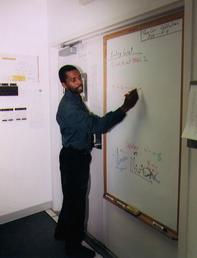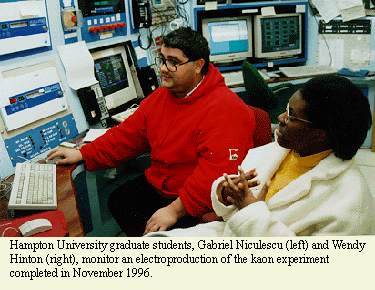 Two experiments recently completed at the Department of Energy's (DOE) Thomas Jefferson National Accelerator Facility (Jefferson Lab) will put scientists one step closer toward understanding the world we live in. The experiments used Jefferson Lab's high energy accelerator and experimental equipment to produce kaons [pronounced Ka- onz], subatomic particles made of quarks, that have puzzled scientists since their discovery almost 50 years ago.
Two experiments recently completed at the Department of Energy's (DOE) Thomas Jefferson National Accelerator Facility (Jefferson Lab) will put scientists one step closer toward understanding the world we live in. The experiments used Jefferson Lab's high energy accelerator and experimental equipment to produce kaons [pronounced Ka- onz], subatomic particles made of quarks, that have puzzled scientists since their discovery almost 50 years ago.
"I am thrilled to have been a part of this historic measurement - the first time that it will have been done with this precision," said Keith Baker, a Hampton University (HU) professor and physicist who is the spokesman for the team of around 90 experimenters from 24 research institutions on one of the experiments. Ben Zeidman, an HU adjunct professor, is the spokesman for the accompanying experiment.
The kaon experiments were the first major experiments, of at least four by HU, to be conducted by faculty from a Historically Black College or University (HBCU) at a national lab concentrating in nuclear physics.
"It was a great accomplishment," said Gabriel Niculescu, the HU doctoral candidate on the experiment. "We were able to prove to ourselves that this experiment could be done. The accomplishment also confirms what we can achieve as human beings."
Many theories and models exist for the kaon, however, none have been proven. The completion of the kaon experiments has caused many to celebrate. Now nuclear physicists await the results.
The experiments, which began October 3 and concluded November 6, 1996, were some of the first of 80 approved for precious beam time at Jefferson Lab - a lab which began its experimental program a year ago after 10 years of construction. Each proposed experiment undergoes a strict review process by a committee made up of top physicists in the country.
Graduate students Niculescu, Jinseok Cha, Wendy Hinton and Ioana Niculescu; and post doctoral fellows, Ketevi Assamagan and Paul Gueye, all from HU, performed critical roles in the success of the experiments. Baker sings high praise for the effort put forth by the group, saying "they all worked very long hours and were under a lot of stress to pull this off."

The complex experimental process for measuring kaons is based on a few scientific principles and the use of Jefferson Lab's unique continuous electron beam accelerator and house-sized experimental equipment.
"Kaons are produced as a result of scattering high energy electrons [electrons traveling at the speed of light] off of protons contained in a certain target," explains Baker. "From this scattering process, both kaons and particles known as hyperons, are detected."
Jefferson Lab's beam of highly accelerated electrons were used to interact with protons from a liquid hydrogen target, adds Assamagan. "Liquid hydrogen is a good target for this experiment because it only has one proton in its nucleus," he explains. "The less protons there are, the easier it is to measure the motion of the particles."
Two detectors, located downstream of the target, detect the particles as they scatter from the target. One detector measures the momentum and direction of the scattered electrons, while the other detects the momentum and direction of the kaons. These two particles must be detected simultaneously in order to ensure that they are produced in the same interaction process.
The probability of creating kaons is very low. In fact, one out of every 1,000 or so detected events will actually be a kaon. "Jefferson Lab's continuous beam of electrons on a target allows the chances of creating kaons to increase," explains Niculescu. "Others were unable to perform a kaon electroproduction experiment as precise as the one we've completed because the equipment and the continuous beam were not available."
The resulting data, currently being analyzed, will provide a better understanding of the kaon, as well as, form a basis for future experiments at Jefferson Lab and elsewhere.
The immediate impact of the experiment will be felt by the four HU graduate students, and Rick Mohring of the University of Maryland. For them, the data taken during the allotted beam-time provides a basis for their theses required to earn doctoral degrees in Physics.
As for the immediate impact or benefit to the rest of the world, "We never know ... perhaps our children and grandchildren may find some practical use for our understanding of the electromagnetic properties of kaons," says Baker. "Meanwhile, we'll continue doing what we do best - pursuing knowledge."
Jefferson Lab is managed and operated for the U.S. Department of Energy by the Southeastern Universities Research Association, Inc., a consortium of 41 universities in the southeast.
Color photos are available. For more information contact Deborah Hyman at (757) 269-5102 or Linda Ware at (757) 269-7689.

